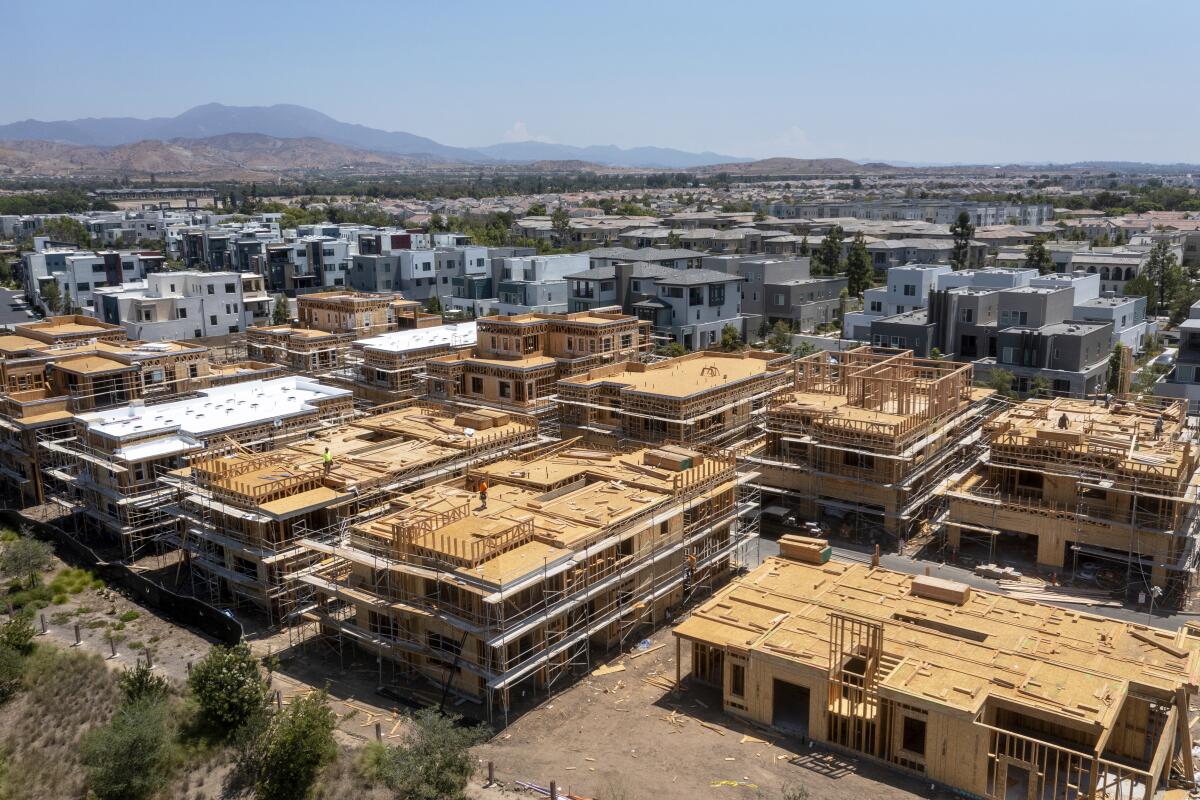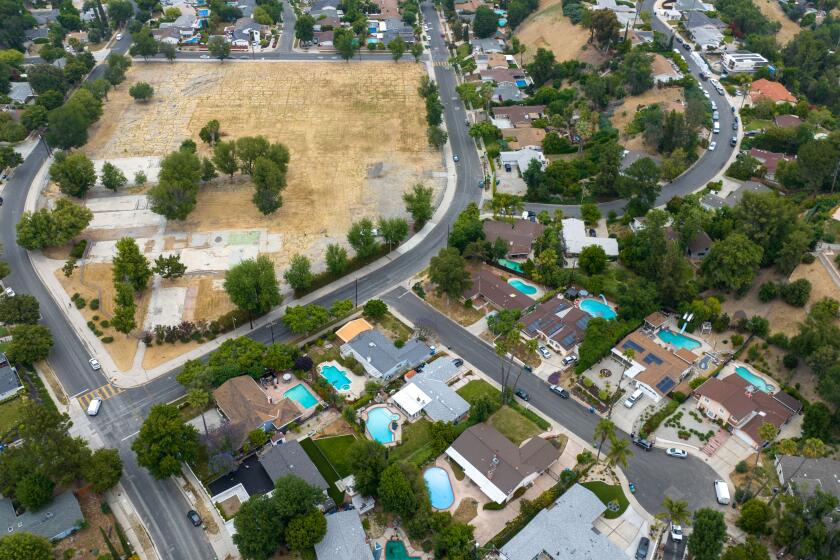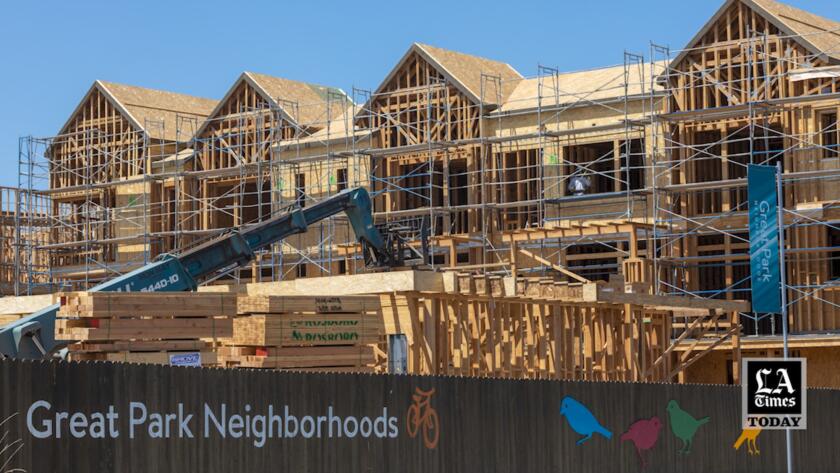California has tried to boost its housing stock. See which states have done better

- Share via
A retired human resources director, Pam Quinn was burned out on the work-intensive culture of Silicon Valley and looking to relocate to a place where she felt like she was “part of a community.”
After searching on her iPad, the widowed 66-year-old empty-nester from the San Jose suburb of Campbell found Twin Oaks, a newly built development in Hollister, described on its website as a “55+ active lifestyle community.” Quinn moved in April of 2022, just as the development was completed.
Hollister is the county seat of San Benito County, California’s leader when it comes to housing units added in the last several years. Between July 2020 and July 2022, the county housing supply went up 4.6%, or 946 units.
San Benito County defied the trends in California, which increased its housing stock by only 1.6% between July 2020 and July 2022, while the U.S. as a whole boosted housing by 2.3%, according to newly released data from the U.S. Census Bureau.
Quinn’s friends in Silicon Valley would tease her, saying, “Hollister, that’s the boonies, you can’t live there,” she said, but her new home, away from the corporate grind and traffic, has turned her life around.
“I’m living in a five-star resort here and it’s absolutely gorgeous,” she said.
Californians are overwhelmingly enamored of the state and appreciate its diversity. Still, about 40% of residents are considering leaving, mostly because of the costs.
Amid California’s housing crisis, the state has scrambled to add enough supply — like the Hollister development — to mitigate skyrocketing rents.
But many states in the U.S. — 31, to be exact — reported more housing growth than California did.
Land costs, environmental restrictions and other factors can explain why California lags behind so many other states in building new housing, said Hans Johnson, a demographer with the Public Policy Institute of California.
“The availability and cost of land in California is different than in many states where housing continues to be built at a faster rate,” he said.
“We have very high housing prices,” Johnson said, and “even though we might be losing people, there is still an unmet demand for more housing.”
There are fewer places to build in California after past housing booms resulted in “large new suburban developments at the edge of the urban fringe” — with places like Orange County and the Inland Empire fueling growth, Johnson said.
“We have limited land to build new housing in areas where demand is great,” he said, and as a result “California has had a hard time building as much housing as many of us think is necessary.”
Additionally, experts believe regulations such as the California Environmental Quality Act, or CEQA, may need to be reformed to “streamline housing building in California,” Johnson said.
“Neighborhood opposition and lawsuits have dampened the ability of jurisdictions to build housing even when they want to,” he said. “New housing developments can be tied up for years as the courts adjudicate the lawsuits.”
While California has been slow at adding housing, some of the fastest growth has been happening in the types of places where fleeing Californians have been known to move, including Utah, Idaho and Texas.
New census data reveals over a quarter of U.S. households had solo occupants in 2020, more than three times the 1940 estimate and more than twice the 1960 level.
In raw numbers, Florida and Texas added more units than California did. Texas added almost 550,000 units in the two-year span, while Florida added almost 400,000. California’s 235,000 additional units amount to less than half of what Texas added in the same time period.
Here are the top 15 states by housing growth including many states popular among residents departing California:
- Utah, 6.7%
- Idaho, 6.0%
- Texas, 4.7%
- South Carolina, 4.3%
- Florida, 4.0%
- Colorado, 4.0%
- North Carolina, 3.9%
- South Dakota, 3.8%
- Delaware, 3.8%
- Tennessee, 3.7%
- Nevada, 3.7%
- Washington, 3.5%
- Arizona, 3.4%
- Georgia, 2.9%
- Montana, 2.8%
Californians’ migration trends have caused controversy in recent years: Utah’s governor told Californians to stay home “instead of coming as refugees.” Boise pushed against increasing California migration, and residents of Los Angeles and San Francisco were confronted with billboards telling them not to move to Texas.
Census data highlight a trend toward weaker housing growth in the Northeast and Midwest and stronger growth in the Southeast and Rockies.
The nation’s recent housing trend seems to line up with America’s politics.
The top five states for housing growth — and eight of the top 10 — voted Republican in the 2020 presidential election. Four of the bottom five voted Democratic, as well as seven of the bottom 10.
After years of dawdling by L.A. on the use of public land for homeless housing, an urban planner hired by the Committee for Greater L.A. has vetted thousands of government-owned parcels and come up with a list of 121 that it says are ready for development.
Johnson pointed to his research, showing that “higher-income Californians who are leaving the state are more likely to go to a state with no income taxes.” Many states without income tax are red states, but Johnson acknowledged, it is “not always a red and blue issue.”
The top destination states for those leaving California include places such as Washington, Nevada and Texas, he said, which tend to run the gamut from liberal to conservative.
Also, surveys by the Public Policy Institute of California show that “people who are conservative are substantially more likely to say that they are likely to leave the state because of high housing prices than people who are liberal,” Johnson said.
Here are the bottom five states by housing growth rate:
46. West Virginia, 0.7%
47. Connecticut, 0.7%
48. New Jersey, 0.6%
49. Rhode Island, 0.5%
50. Illinois, 0.5%
Among the nation’s cities that have added housing the fastest, the Census Bureau said in a news release that “[n]ine of the nation’s 15 fastest-growing cities were in the South” last year, with six of those in Texas, the state with the third-largest housing growth.
The release highlighted counties with exceptionally high growth: “Wasatch County, east of Provo, Utah, was the fastest-growing county,” with a 7.7% housing increase between July 2021 and July 2022, the report said. Other notable counties include Rockwall County, northeast of Dallas, Texas — 7.4% — and St. Johns County, south of Jacksonville, Fla., at 6.6%.
Back in Hollister, Quinn recalled the snarling traffic in Silicon Valley and the frantic lifestyle her neighbors lived.
“You’re out the door at 6 in the morning, you crawl in at 7 at night,” she said. “That’s the reality of living in Silicon Valley now.”
But now she’s about 50 minutes away from her children and grandchildren in the Bay Area — provided that she drives when traffic is light.
“The overall quality of life here” is better, she said, with a lower stress level than in the suburbs of San Jose. “People are looking for that balance.”
Sign up for You Do ADU
Our six-week newsletter will help you make the right decision for you and your property.
You may occasionally receive promotional content from the Los Angeles Times.
- Share via
Watch L.A. Times Today at 7 p.m. on Spectrum News 1 on Channel 1 or live stream on the Spectrum News App. Palos Verdes Peninsula and Orange County viewers can watch on Cox Systems on channel 99.
More to Read
Sign up for You Do ADU
Our six-week newsletter will help you make the right decision for you and your property.
You may occasionally receive promotional content from the Los Angeles Times.















